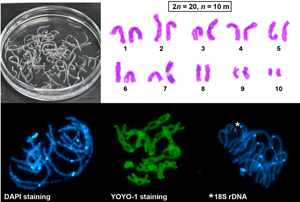Published online by Cambridge University Press: 10 May 2022

Caryophyllideans are intestinal parasites of freshwater fishes, occupying a basal position among the ‘true’ tapeworms. We performed detailed cytogenetic analyses of the well-known caryophyllidean species Caryophyllaeus laticeps. For comparison, we also examined for the first time the chromosomes of Paracaryophyllaeus gotoi, a specific parasite of loaches in China. Both species showed a diploid chromosome number of 2n = 20, n = 10m. Chromomycin A3 (CMA3)/diamidino-2-phenylindole (DAPI) staining performed for the first time in the class Cestoda revealed CMA3+/DAPI− bands in the pericentromeric regions of the short arms of chromosome pair no. 7 in the karyotype of C. laticeps. Fluorescence in situ hybridization with the 18S rDNA probe confirmed the presence of a single cluster of major rDNA near the centromere on a pair of small chromosomes in both species. These findings support the hypothesis that the ancestral state in the family Caryophyllaeidae is a single interstitial cluster of major rDNA genes and thus one nucleolar organizer region per haploid genome. Our results, which we presented together with literature data plotted on a phylogenetic tree, show stability of caryophyllidean karyotypes at the genus level, but showed differences between genera without a clear phylogenetic signal. The data allowed us to at least formulate a hypothesis about the ancestral haploid chromosome number of n = 10 for the family Caryophyllaeidae and possibly for the sister family Capingentidae. In addition, we compared two populations of C. laticeps from water bodies with different levels of polychlorinated biphenyl contamination, showing a slightly increased incidence of chromosomal abnormalities at the contaminated site.